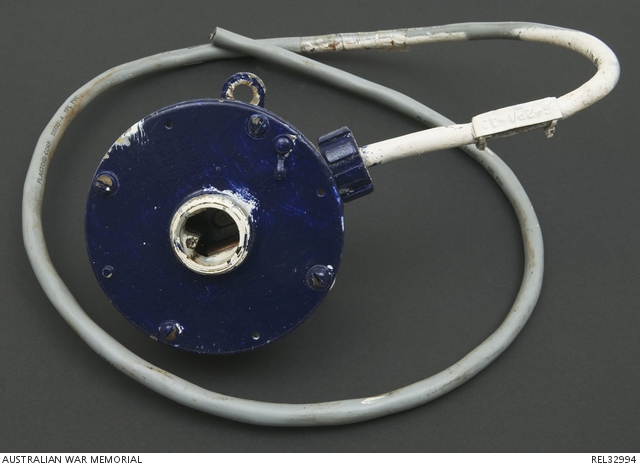| Accession Number | REL32994 |
|---|---|
| Collection type | Technology |
| Object type | Maritime vessel or watercraft |
| Maker |
Unknown |
| Date made | Unknown |
| Conflict |
Gulf War, 1990-1991 Vietnam, 1962-1975 |
HMAS Brisbane : Gun Plot Room : Electrical box

The electrical box has a pressed circular brass body with a circular front plate. The unit is partially painted dark blue. The front plate has a centrally mounted female electrical socket (cover missing). At the base of the unit a white/grey power cord is protruding. On the back of the unit are three brackets used to secure it to the wall. The brackets say 52, Fire and Key respectively. (This unit goes with Gun Trigger Handle 52 from GPR).
This component was removed from HMAS Brisbane after the ship was de-commissioned in 2001. The electrical box provides a socket for the Gun Firing Trigger Handle (REL32980.069). The box is part of the Mk 68 Mod 4 Gun Fire Control System used to control the ship’s two 5 in. 54 calibre guns. HMAS Brisbane [II] was commissioned into the Royal Australian Navy in December 1967 and was the second vessel of that name to serve in the RAN. Known officially as DDG-41, Brisbane was the third of the RAN's American-built "Charles F. Adams" class guided-missiles destroyers. This class were the first major Australian warships designed and built in America, and were constructed by the Defoe Shipbuilding Co. The original complement of the Brisbane was 20 officers and over 300 sailors. Main armament was two 5-inch/54 calibre guns and anti-submarine torpedoes. The Ikara missile system was subsequently added. In later service the ship was known by the nick-name ‘the Steel Cat’. The HMAS Brisbane saw operational service in two conflicts. During the Vietnam War the ship undertook two tours of duty with the United States Seventh Fleet, in 1969 and again in 1971. The ship’s major task was to provide gunfire support for the land campaign. During the Gulf War (1990-91), Brisbane was one of four Australian warships to serve a tour in Gulf waters. The Brisbane arrived in the Gulf in December 1990 and operated there until March 1991, performing a number of roles. Apart from contributing to the anti-aircraft defences in the carrier screen, the ship also kept watch for mines and ensured that small civilian craft kept well away from the carrier group. Later, during Operation Desert Storm, the Brisbane controlled fighter combat air patrols and tanker aircraft. The ship’s final role was as an escort for US replenishment ships. In 2003 HMAS Brisbane was retired from service in the Royal Australian Navy. The Brisbane was the last steam powered ship in the RAN. HMAS Brisbane was sunk as a recreational dive wreck off the coast of southern Queensland in July 2005.